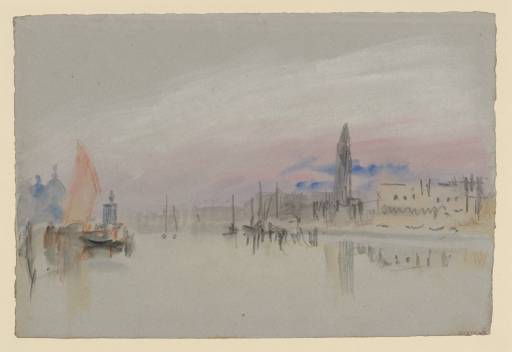Joseph Mallord William Turner Boats on the Bacino, Venice, with Santa Maria della Salute, the Dogana, the Campanile of San Marco (St Mark's) and the Palazzo Ducale (Doge's Palace) 1840
Joseph Mallord William Turner,
Boats on the Bacino, Venice, with Santa Maria della Salute, the Dogana, the Campanile of San Marco (St Mark's) and the Palazzo Ducale (Doge's Palace)
1840
Joseph Mallord William Turner 1775–1851
Boats on the Bacino, Venice, with Santa Maria della Salute, the Dogana, the Campanile of San Marco (St Mark’s) and the Palazzo Ducale (Doge’s Palace) 1840
D32184
Turner Bequest CCCXVII 5
Turner Bequest CCCXVII 5
Gouache, pencil and watercolour on grey wove paper, 188 x 280 mm
Blind-stamped with Turner Bequest monogram towards bottom right
Stamped in black ‘CCCXVII – 5’ bottom right
Blind-stamped with Turner Bequest monogram towards bottom right
Stamped in black ‘CCCXVII – 5’ bottom right
Accepted by the nation as part of the Turner Bequest 1856
Exhibition history
1974
Turner 1775–1851, Royal Academy, London, November 1974–March 1975 (561, as ‘Venice: the Entrance to the Grand Canal with the Campanile and Doge’s Palace’, 1840).
2003
Turner and Venice, Tate Britain, London, October 2003–January 2004, Kimbell Art Museum, Fort Worth, February–May 2004, Museo Correr, Venice, September 2004–January 2005, Fundació ”la Caixa”, Barcelona, March–June 2005 (126, as ‘The Entrance to the Grand Canal, with the Campanile and the Doge’s Palace’, 1840, reproduced in colour).
2007
Colour and Line: Turner’s Experiments, Tate Britain, London, April–November 2007 (no catalogue).
References
1909
A.J. Finberg, A Complete Inventory of the Drawings of the Turner Bequest, London 1909, vol.II, p.1022, CCCXVII 5, as ‘Entrance to the Grand Canal’.
1930
A.J. Finberg, In Venice with Turner, London 1930, p.175, as ‘Entrance to the Grand Canal’, 1835.
1835
John Rothenstein and Martin Butlin, Turner, London 1964, pl.100a, as ‘Entrance to the Grand Canal’, 1835.
1974
Andrew Wilton in Martin Butlin, Andrew Wilton and John Gage, Turner 1775–1851, exhibition catalogue, Royal Academy, London 1974, p.157 no.561, as ‘Venice: the Entrance to the Grand Canal with the Campanile and Doge’s Palace’, 1840, p.160 under no.582, as among similar sheets probably used in 1840.
1840
Lindsay Stainton, Turner’s Venice, London 1985, p.50 no.31, as ‘The entrance to the Grand Canal with the Campanile and the Ducal Palace’, ?1840, pl.31 (colour).
2003
Ian Warrell in Warrell, David Laven, Jan Morris and others, Turner and Venice, exhibition catalogue, Tate Britain, London 2003, pp.215, 259, 272 no.126, as ‘The Entrance to the Grand Canal, with the Campanile and the Doge’s Palace’, 1840, fig.232 (colour).
2005
Ian Warrell, Cecilia Powell and David Laven, Turner i Venècia, exhibition catalogue, Fundació ”la Caixa”, Barcelona 2005, p.165 no.96, as ‘L’entrada del Gran Canal amb el Campanile i el Palau Ducal’, 1840, reproduced in colour.
This is a pictorial, simplified treatment of the well-known Bacino scene, supposedly from off the Isola di San Giorgio Maggiore, looking west-north-west to the domes of Santa Maria della Salute and the porch of the Dogana at the entrance to the Grand Canal, and north to the campanile of San Marco (St Mark’s) and the Molo front of the Palazzo Ducale (Doge’s Palace). Compare Tate D32150 (Turner Bequest CCCXVI 13) a contemporary colour study on pale grey-white Italian paper; the present view is effectively a cropped variant of the wider prospect there.
Ian Warrell has noted that this grey sheet and the technically similar D32201 (CCCXVII 16), a closer view of the Salute and Dogana, ‘combine the economy of Turner’s graphic shorthand with broadly applied pastel washes’;1 compare also D32200 (CCCXVII 15), a less developed Salute view.2 He continues: ‘The reductive quality of the draughtsmanship ... means that the architectural features of the Doge’s Palace are barely individualised, and yet there is somehow enough for the eye familiar with the original to make sense of Turner’s squiggles and dashes.’3
Technical notes:
Heavy pencil has been used over existing colour for details including masts and the articulation of the Doge’s Palace and its reflection, while the sky has been heightened with soft stokes of white. Ian Warrell has suggested that Turner ‘may also have experimented here with the use of a red chalk or crayon to build up some of his detail’,1 at the far left and right.
This is one of numerous 1840 Venice works Warrell has noted as being on ‘Bally, Ellen and Steart grey paper’ which Turner had also used on his Continental tour of 1833, including Venice, and therefore ‘the dating of some of these sheets in uncertain’ (see in particular Tate D32205–D32210; Turner Bequest CCCXVII 20–25); the following ‘seem to arise from the later visit’:2 Tate D32180–D32181, D32183–D32184, D32200–D32201, D32203–D32204, D32212, D32215, D32217 (Turner Bequest CCCXVII 1, 2, 4, 5, 15, 16, 18, 19, 27–30, 32); see also Venice: San Giorgio Maggiore and the Zitelle from the Giudecca (currently untraced)3 and The Doge’s Palace from the Bacino (private collection),4 and two further ‘half-size sheets’:5 Tate D33883 (Turner Bequest CCCXLI 183), and Shipping with Buildings, ?Venice (Fitzwilliam Museum, Cambridge).6
Verso:
Blank; inscribed in pencil ‘17’ above centre, ascending vertically; stamped in black with Turner Bequest monogram over ‘CCCXVII – 5’ towards bottom left; inscribed in pencil ‘D32184’ and ‘CCCXVII.5’ bottom right.
There are splashes or offsets of ochre colour at the bottom left and centre right. Indentations from the heavy pencil work on the recto are evident, and appear pale as if they have picked up white pigment from another sheet.
Matthew Imms
July 2018
How to cite
Matthew Imms, ‘Boats on the Bacino, Venice, with Santa Maria della Salute, the Dogana, the Campanile of San Marco (St Mark’s) and the Palazzo Ducale (Doge’s Palace) 1840 by Joseph Mallord William Turner’, catalogue entry, July 2018, in David Blayney Brown (ed.), J.M.W. Turner: Sketchbooks, Drawings and Watercolours, Tate Research Publication, December 2019, https://www

